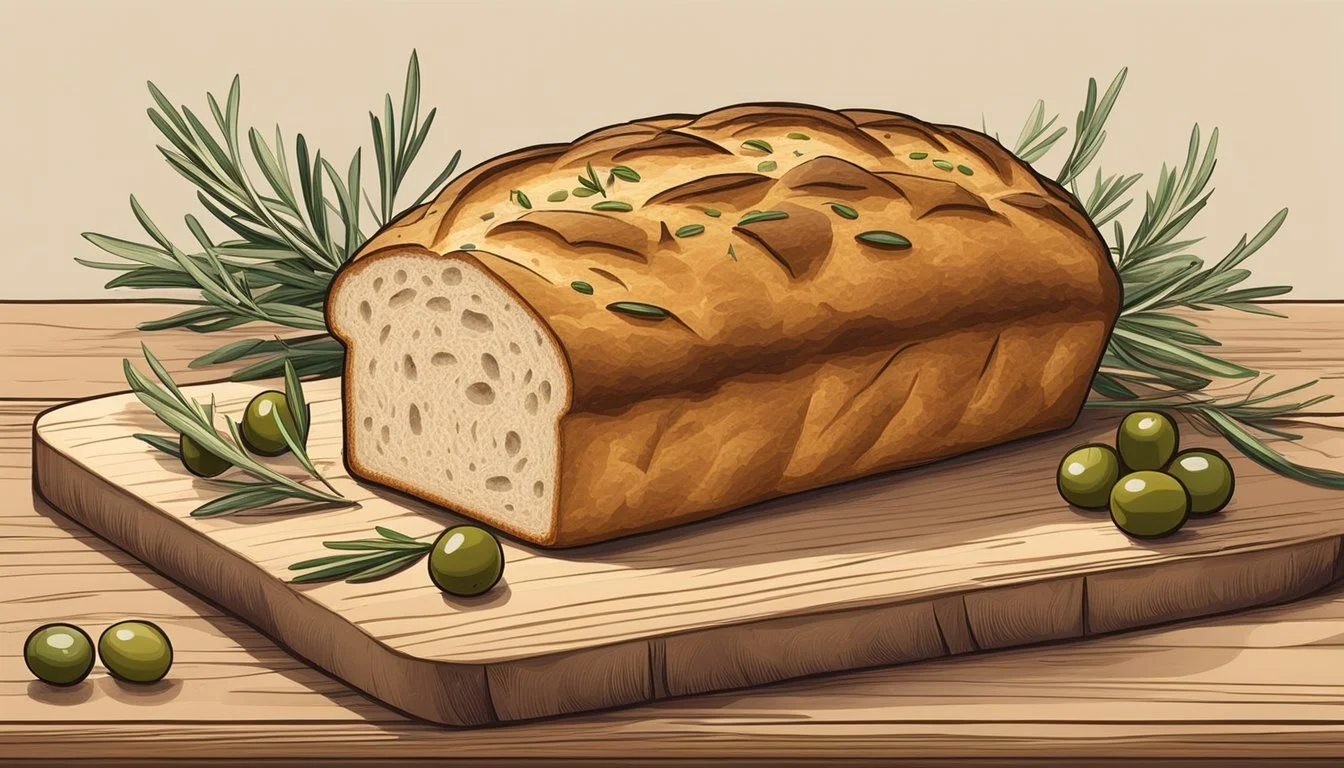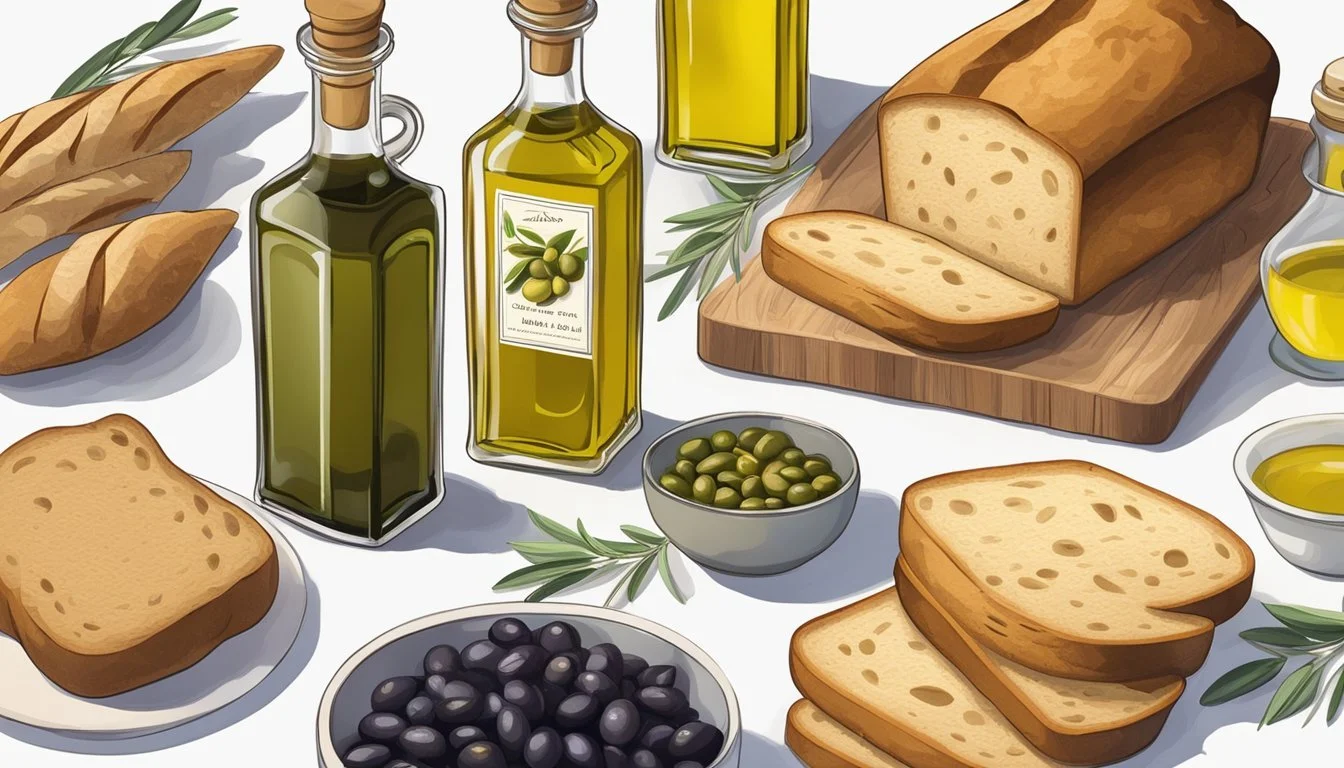Olive Bread Substitutes
Top Alternatives for Your Recipes
Olive bread, cherished for its rich flavor imbued with the distinct taste of olives and olive oil, is a favorite for many who enjoy a Mediterranean touch to their meals. The bread typically combines the savory notes of olives with a hearty texture, making it a sought-after choice for sandwiches or as an accompaniment to soups and salads. Its unique taste, often enhanced by herbs such as rosemary or thyme, offers a culinary experience that stands out from more traditional types of bread.
For those looking for olive bread substitutes, several alternatives can complement a meal in a similar fashion while offering their own health benefits and taste profiles. Substitutes may be considered for a variety of reasons, including dietary restrictions, carbohydrate intake control, or simply the desire to explore different flavors. Options range from low-carb alternatives like cloud bread for those on keto diets, to robust, no-knead varieties that maintain the essence of olive bread without the kneading process.
Recipes for these substitutes often incorporate ingredients such as olive oil to emulate the moist, dense texture and aromatic flavor of olive bread. Health-conscious individuals might select alternatives that incorporate whole grains or seeds to increase nutritional content. Each alternative carries its own unique flavor and textural nuances, providing a spectrum of choices for enthusiasts looking to broaden their bread horizons while still enjoying the essence of olive-infused baked goods.
Understanding Olive Bread
Olive bread embodies the essence of Mediterranean cuisine, combining the simplicity of bread with the robust flavors of the region's signature olives. This section aims to deconstruct olive bread to its core components, exploring the fundamental ingredients and their contributions to its texture and taste, as well as typical food pairings that intensify the bread's character.
Key Ingredients
Bread Flour: Provides structure and chewiness to the olive bread's texture.
Water: Hydrates the flour, activating the gluten for elasticity.
Yeast: Facilitates fermentation, causing the dough to rise for a light crumb.
Olives: Kalamata olives are frequently used for their buttery and peppery flavor profile.
Olive Oil: Often incorporated to add a mild and slightly bitter undertone, enhancing the bread's moisture and texture.
Distinctive Flavors
Olive bread is lauded for its intricate flavor balance, with a base that is typically salty and umami from the inclusion of olives. Varying types of olives, such as the Kalamata variety, lend a buttery and slightly peppery taste, which is further influenced by the possible addition of herbs like rosemary or thyme. The result is a flavor profile that is both bold and nuanced, making olive bread a standalone delicacy but also an adaptable accompaniment.
Common Pairings
The flavor profile and texture of olive bread make it especially suitable for:
Charcuterie (What wine goes well with charcuterie?) Boards: Complementing cured meats with its salty and umami flavors.
Cheese Platters: The robust taste of olive bread pairs well with a variety of cheeses.
Salads: Serving as a hearty and flavorful component alongside greens and vinaigrettes.
Olive Oil Substitutes
When a recipe calls for olive oil, a variety of substitutes can be used depending on the intended use, such as cooking, baking, or dressing. The appropriate substitute often hinges on factors like smoke point, flavor profile, and the texture desired in the finished product.
For Cooking
For high-heat cooking methods like frying, sautéing, and roasting, it is crucial to choose an oil with a high smoke point to prevent burning.
Avocado oil: Refined avocado oil is an excellent substitute for olive oil given its high smoke point of 520°F, making it suitable for cooking in a Dutch oven or on a baking sheet.
Canola oil: With a neutral flavor and a high smoke point, canola oil can often replace olive oil in equal parts for various cooking needs.
Coconut oil: Although it imparts a distinct taste, coconut oil is another option that can sustain high cooking temperatures.
For Baking
In recipes such as muffins or cakes, where olive oil contributes to a moist and dense texture, substitutes should retain moisture without overpowering other flavors.
Butter: For a rich and savory flavor, butter can replace olive oil in a 1:1 ratio for cooking; however, for baking, use ¾ cup of butter for every 1 cup of olive oil.
Vegetable oil: Like canola, most vegetable oils have a neutral taste and can be used in the same amount as olive oil.
For Dressings and Marinades
The ideal substitutes for dressings and marinades are oils that complement the flavors of the dish and do not overpower the salad greens or marinated ingredients.
Extra Virgin Olive Oil: If the recipe calls for virgin olive oil, extra virgin olive oil can be used for its similar taste profile.
Walnut oil: It offers a nutty flavor suited to dressings and marinades when a more pronounced taste is welcome.
Canola oil: For a neutral flavor, canola oil is an appropriate substitute that will not alter the expected taste of the dish.
Health Considerations
When considering olive bread substitutes for health reasons, it's important to evaluate their nutritional content. Olive bread, known for its incorporation of olives, can be rich in monounsaturated fats, which are beneficial for heart health. These fats help reduce bad cholesterol levels, thereby lessening the risk of heart disease.
Alternatives to olive bread might lack monounsaturated fats but can offer their own health benefits. For instance, lettuce wraps or buns provide a low-calorie option that's also low in saturated fat, potentially improving cholesterol levels. These substitutes can be fortified with heart-healthy fats by adding ingredients like avocado, which is high in antioxidants and omega-3 fatty acids. Cloud bread, another alternative, serves as a low-carb, high-protein option suitable for those on ketogenic diets.
Here is a brief nutritional comparison of olive bread and selected substitutes:
Substitute Monounsaturated Fats Saturated Fat Cholesterol Omega-3 Fiber Notable Vitamins Olive Bread High Moderate Moderate Low Medium E, K Lettuce Wraps Low Low None Low High A, K, Iron Cloud Bread Low Low Varies Low Low B vitamins, Calcium
Enriching one's diet with vitamins like E and K can be done via olive oil dressings on alternatives, which also supplies additional iron and copper. Adding diverse toppings or fillings like nuts and seeds can provide more nutrition and a boost in minerals like calcium.
To sum up, selecting a bread substitute requires consideration of the specific nutritional needs and health goals of an individual. Integrating a variety of these options can cater to both dietary restrictions and preference for a balanced diet.
Substitute Ingredients for Olives in Bread
When crafting olive bread, several ingredients can serve as suitable substitutes for olives, providing a similar texture or complementing flavor profiles. Below are some specific alternatives organized into categories for easy reference.
Vegetable Alternatives
For those looking to replicate the texture and brininess of green olives or black olives in bread, various vegetables offer a close match:
Capers: These small buds provide a tangy lemony flavor akin to olives. A direct one-to-one substitute is often effective.
Artichoke Hearts: Chopped artichoke hearts have a meaty texture and can offer a milder taste that pairs well with bread.
Pickled Peppers and Pickled Tomatoes: These bring a vibrant, tangy flavor to the bread, much like olives, yet with a distinctively different taste.
Pickled Onions: Their slightly sweet and tangy flavor can brighten up bread in the absence of olives.
Mushrooms: Diced and sautéed for an umami-packed, earthy flavor, mushrooms are an excellent olive substitute.
Cheese and Condiments
Cheese and condiments can add depth and richness to the bread, making them excellent substitutes for olives:
Blue Cheese: Crumbled blue cheese provides a tangy and salty flavor with a creamy texture that can stand in for olives.
Dill Pickles: Finely chopped, they add crunch and zest, somewhat mimicking the piquancy of olives.
Anchovies: Minced anchovies introduce a salty, intense umami character, suitable for olive lovers craving that strong savoriness.
Green Peppercorns: These can be crushed or whole, lending a mild peppery taste to the bread without overwhelming the other flavors.
Nut and Seed Oils
Nut and seed oils offer a more subtle approach to replacing olives in bread, providing richness and a hint of the nuanced flavors that olives contribute:
Nut Oils: A drizzle of nut oils such as walnut or almond oil can infuse bread with a subtle, underlying depth of flavor.
Sunflower Oil and Grapeseed Oil: These oils have a neutral taste and can be used to moisten the bread dough while providing a healthful fat content without the stronger taste of olives.
Recipes and Usage Tips
In this section, readers will discover substitute recipes for olive bread and learn effective cooking techniques to achieve a comparable taste and texture. The focus is on maintaining the unique qualities of traditional olive bread using different ingredients.
Alternative Recipes
Olive Oil-Based Herb Bread: When olives are not available, readers can still capture the essence of olive bread. They should substitute 1 cup of chopped, pitted olives with 3 tablespoons of finely chopped fresh herbs such as rosemary or thyme. This substitution helps maintain the bread's aromatic profile while introducing a light, herbaceous note.
Substitution Ratio: 3 tablespoons of fresh herbs per 1 cup chopped olives
Tips: Use high-quality olive oil to impart a mild olive flavor.
Seeded Multigrain Bread: To recreate the texture of olive bread without olives, one might use a variety of seeds, such as sunflower, flax, or pumpkin seeds. These seeds offer a nutty flavor and a satisfying crunch.
Substitution Ratio: 1 cup of mixed seeds per 1 cup chopped olives
Tips: Toasting the seeds beforehand enhances their flavor and aroma.
Cooking Techniques
Baking Adjustments: When substituting other ingredients for olives, bakers must adjust moisture content and baking times. Olives add moisture to the dough, so recipes may require slight reductions in added water or oil.
Tip: For a crispier crust, mist water into the oven during the initial stage of baking.
High-Temperature Considerations: Both olive bread and its substitutes benefit from baking at high temperatures. This method ensures a well-developed crust and a fully-cooked interior.
Tip: Preheat the baking vessel, such as a Dutch oven, to create a steamy environment that mimics a professional oven.
Temperature Range: An oven temperature of 425°F to 475°F is optimal for baking breads that include hearty ingredients like seeds.
Incorporating these substitutions and techniques allows home bakers to recreate the delightful experience of olive bread through alternative recipes while preserving its characteristic light flavor and pleasing texture.
FAQs and Expert Advice
When making olive bread, selecting appropriate substitutes and understanding their storage can greatly impact both the flavor and shelf life of your bread. Expert advice can assist bakers in tailoring recipes to their tastes while maintaining the health benefits and structure of the bread.
Selecting the Right Substitutes
For olive oil in bread recipes, one can choose between extra-virgin olive oil (EVOO) and virgin olive oil based on the desired flavor profile. EVOO is known for its robust flavor and higher concentration of healthy fats, particularly monounsaturated fatty acids. Virgin olive oil offers a milder taste, suitable for those who prefer a subtle olive essence.
EVOO: Intense, full-bodied flavor; ideal for a pronounced olive taste.
Virgin Olive Oil: Milder flavor; recommended if one seeks to avoid overpowering other ingredients.
In terms of health benefits, both types of olive oil contribute to the nutritional value of olive bread, making it a source of healthy fats. When selecting an alternative, it's crucial to choose one with a similar health profile, such as avocado oil, to maintain those benefits.
Storage and Shelf Life
Proper storage is key for preserving the freshness of olive bread and extending its shelf life. Bread should be stored at room temperature in a cool, dry place, typically in a bread box or airtight container to prevent staleness.
Storage Method Shelf Life Notes Room Temperature 3-4 days Bread box or airtight container recommended. Refrigerated Not recommended Can cause bread to dry out faster. Freezer Up to 3 months Slice before freezing for convenience; thaw at room temperature.
Expert advice generally cautions against refrigeration, as it may lead to a loss of texture and moisture. Freezing, however, is a viable option for long-term preservation. In all cases, ensuring the bread is wrapped properly will impede the entrance of moisture and prevent freezer burn.
When infusing bread with olive oil, one must consider the method of incorporation, as direct addition versus a post-baking brush can affect both flavor and shelf life. Health-conscious consumers can also look for oils with similar profiles of monounsaturated fats for substitution, to ensure the health benefits remain uncompromised.







